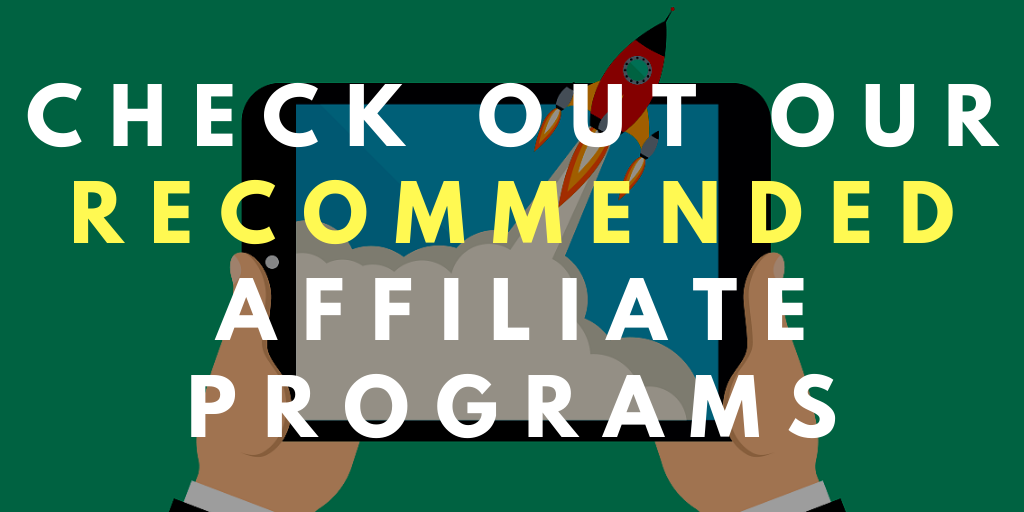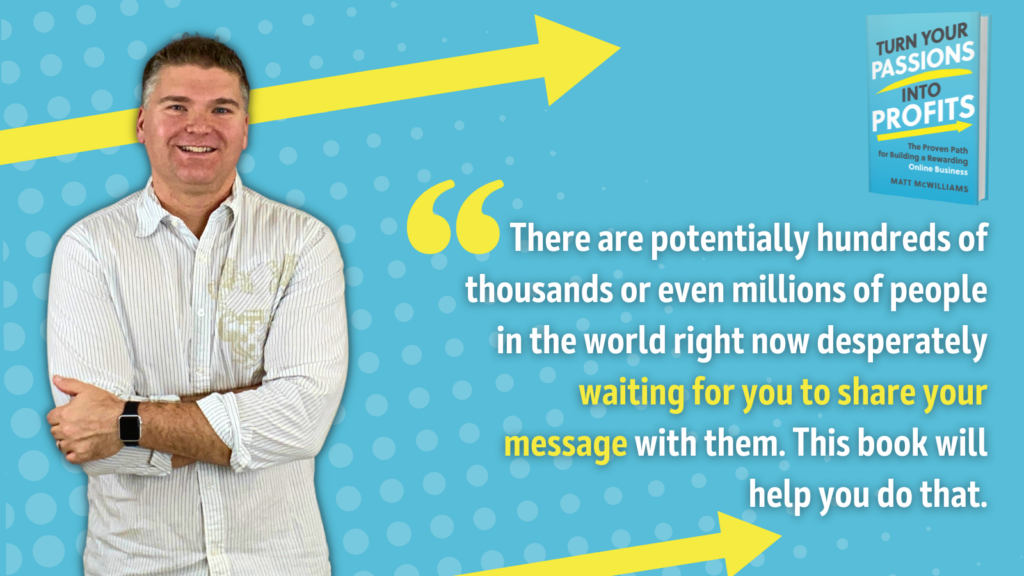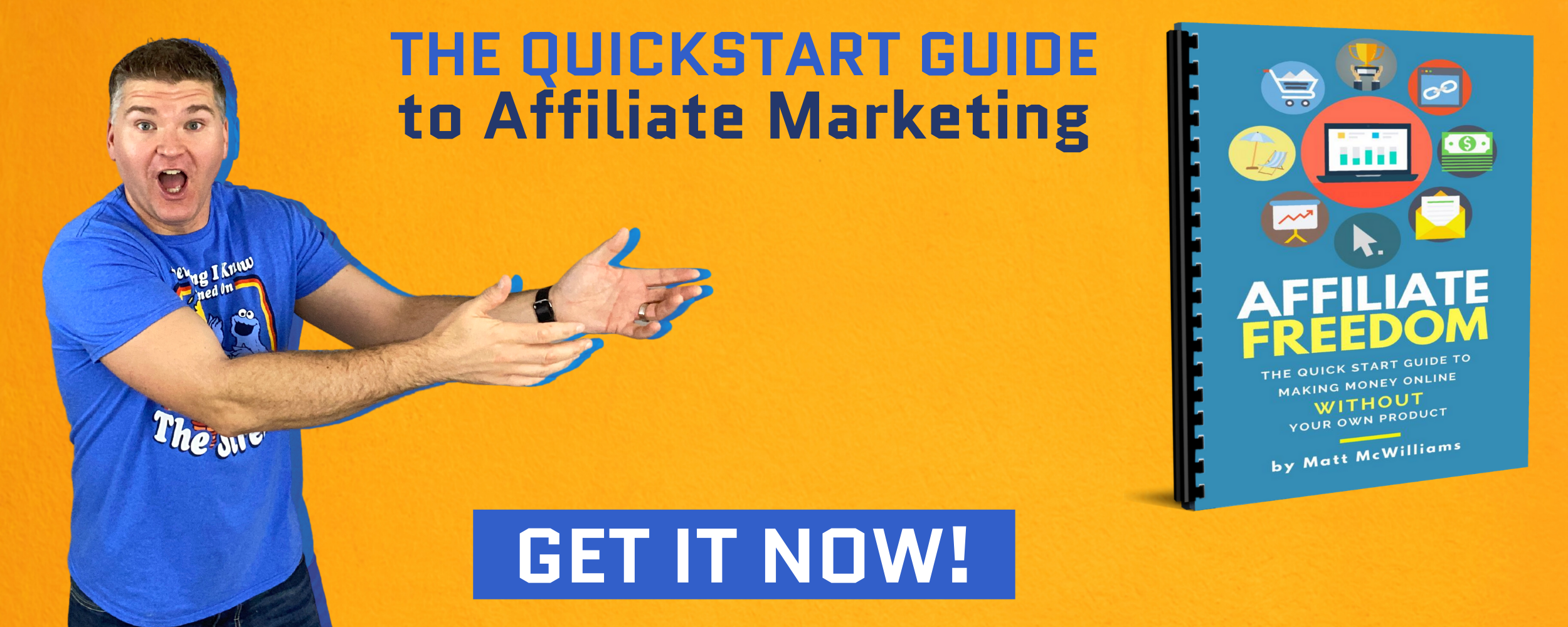Are you tired of just “thinking about” writing a book, even making it a New Year’s Resolution or a goal for this year…but never actually making it happen? Are you looking for a map that will take you from blank page to published author as fast as possible… without the frustration, heartache, and the dreaded staring at a blank page? Today’s guest is going to show you the step-by-step process to write, publish, and SELL your book.
Click Here for The Written Transcript of This Episode
Links Mentioned in this Episode
Get a 100% FREE copy of Chandler Bolt’s book “Published” here
Affiliate Marketing for Authors Training
Don’t Miss An Episode – Subscribe Below
Previous Episodes of The Affiliate Guy
How to Use Affiliate Marketing in a Book
How to Run an Affiliate Book Launch
How to Find Affiliates for a Book Launch (or Any Launch)
What & How to Communicate to Your Affiliates
How to Use Leaderboards to Find Affiliates
How to Write, Publish, and SELL Your Book with Chandler Bolt
Are you tired of just thinking about writing a book? Maybe you’ve made it a New Year’s resolution or made it a goal for this year, but you’ve never actually made it happen. Maybe you’re looking for a map that will take you from a blank page to a published author as fast as possible while avoiding the frustration, the heartache that dreaded staring at a blank page. If so, today’s guest is going to show you the step-by-step process to write, publish, and sell your book. So this is the final episode in our book series, part four of this four-part series. And this has been fun. It has been really fun for me to dive into this one topic. It’s a commitment on my part to commit to an entire 12th of the year, almost 10% of our podcast content for 2022 about one little topic about books. I don’t know. I wouldn’t say it was a dangerous commitment, but I was nervous about it.
The response has been amazing. And so thank you to everyone who’s reached out to me, who’s left a rating in review on the podcast, specifically about this series, who just reached out to me on social media or texted me, who sent me whatever, sent me an email, just saying thank you. Great job. Enjoyed the series. Whatever it’s been, it’s been awesome. I got a text. Oh, my gosh, I got one earlier today. By the way, if you ever want to text me, just feel free to text me anytime at 260-217-4619. And this guy, he just said, I’m in that 81%, Matt. I’m in the 81% that has been talking about writing a book for ten plus years, and I’m finally taking action based on the series. Well, I told him I’m like, okay, you got to listen to the fourth episode because that’s the one that’s going to help you take action on what we’ve been talking about, like going out and finding affiliates. That’s great. Running an affiliate launch using affiliate marketing. Your book, those are all great. But you got to write the book. You got to publish the book.
And that’s what today’s episode is all about. Real quick. We talked about it through the series. Just remember, you can get the full affiliate marketing for authors training at mattmcwilliams.com/Authors. I’ve got three lessons there. Totally free. Also super crazy. I’m interviewing Chandler Bolt, who in my opinion is one of the leading experts about writing and publishing a book. If you want to get a 100% free copy, no free plus shipping. So you’re not paying to ship. None of that. I’m not against that. I think it’s a great deal. But none of that. No, buy the book, blah, blah, blah. Like, next thing, all that stuff. Keep listening to find out how to get a 100% free copy of his book published. I’ve got it on my shelf. We talked about it in this episode a little bit. It’s a phenomenal book I’m reading, and I’ve just finished the last section I’m going to read for right now. There are a couple more sections I’m going to read probably in a couple of months when I need them. But I’m taking what he talks about in the book. This is somebody I could call him up and be like, hey, walk me through it. But he honestly would just say, hey, go read this chapter. You don’t have to be on the phone with me. We don’t have to coordinate our schedules. You can read this chapter, and it’ll walk you through exactly what I would say.
So about Chandler real quick. Chandler is a former client. He’s become a dear friend. I was introduced to him, I think it was 2014 by a mutual friend. Who this guy Chandler was starting this company Self Publishing School. We kind of wanted to learn the affiliate game, better than to introduce him to me, and he introduced him to me. We kind of hit it off. We talked for over an hour. I shared a bunch of stuff, and then I looked them up after the call. And the fifth Google listing down was a podcast interview with a friend of mine, Roy Vaden. And it was like Seth Bolt. I need to breathe Seth Bolton, his brother Chandler. And I’m like, wait, what is he really the brother of the bassist in one of my favorite bands? Like, one of the founding members of my favorite band. So I texted him back, or I think I called him back, and I was like, dude, is your brother Seth Bolton? He’s like, yeah. I’m like, unbelievable. This is amazing. I can hear him typing. He’s like, hey, man, they’re going to be in Indianapolis, which is 2 hours. They’re going to be in Indianapolis Thursday. This is like a Monday. Do you want to go? Yeah. So three days later, boom, 7th row, center stage. First, need to Breathe show rocked it out. Like, just amazing. Fast forward, I think two years later, he’s a client, and we’re backstage with Needtobreathe down in Atlanta, hanging out with them. We were actually going through some of the photos the other day because they’re finally coming to Fort Wayne. I think about, I don’t know, two months after this episode airs, we’re going to be at the Needtobreathe show here in Fort Wayne. I’m so excited because we’ve always had to travel to go see them. So can’t wait to get to see an acoustic show, but that’s how we connected.
Looking for some good affiliate programs to promote? Check out our recommended affiliate programs here!
He’s just got an amazing story. He’s a College dropout from College dropout. He was like a C-level English student, kind of like me. I was a B minus so got you there. Chandler, like that matters, right? All the way from that. To CEO of Self Publishing School. He’s authored six books, helped more than 6000 aspiring authors, and published a book. Their students have published over 100 books. It’s absolutely amazing stuff. And his mantra is Books change lives. So keep listening to find out how he does it, how you can write, publish and sell your book.
Matt: Chandler, welcome, buddy.
Chandler: Matt, great to be here. Thanks for having me.
Matt: Oh, my gosh. We’ve been wanting to do this for a while. I got sick right now in the middle. We almost had to cancel the day, which I’m so glad. Our Internet is working and yours is working because we’re both having a snowpocalypse. Mine is 14 inches. Yours is a fourth of an inch, but a fourth of an inch in Austin, Texas, is a grind to a halt.
Chandler: Yes.
Matt: I mean, as we record I didn’t tell you this before. I interviewed as we recorded this, my parents are stranded in the Atlanta airport because they literally can’t fly into Austin right now because there’s a millimeter and a half of an inch or vice or whatever there is. But we’re currently trying to figure out how to get them landed in Austin, Texas. Yeah. They shut down the roads here today. Said do not travel unless you have to. I’m like, what some serious stuff that explains why there are no cars going by your house. Well, man, I’m excited about this because we’re talking about you don’t know this, but this will be the fourth episode and a four-episode series on books and affiliates. And with you, we’re going to cover all kinds, we’re going to cover some stuff that’s just general books. We’ll cover the affiliate side. Because I know that’s near and dear to you. It’s driven a lot of your business. We’ll cover all kinds of stuff because you’re the guy. I will just say your name. When I think of books, I think of Chandler Ball. When I think of certain of self-publishing, I think of Chandler Bolt. But just books in general, because so much of what you talk about is the writing process, the creative process, and yes, the marketing process, which we’ll talk about today. I’m kind of curious because I know a little bit of your backstory, but I don’t know that I know how you a College dropout so immediately College drop out. We do not equate that with book experts. How did you get into books? What became the thing that just made like books you’re calling?
Chandler: Yes. I mean, books changed my life. And I believe that books changed lives. I mean, it’s kind of a fundamental belief that I believe books change the lives of readers. And it’s like how many of you listening or watching have had your life changed by book? Right. Probably almost everyone. But then books change the lives of authors. So it’s not about the book it’s about who you become in the process of writing and publishing that book. And so I think you’ve just seen this in the process of writing and publishing your book Matt but for me, that was as a C level English student and College drop out with ADHD I dropped out of school because I was tired of learning how to run a business from professors who have never had businesses that didn’t make sense to me. But I said you know what? When I drop out I need to act like I’m still in school and I kind of convinced my mom to divert a little bit of my College funds instead of going to class I was going to conferences instead of textbooks I was reading books and the smartest, most successful people on the planet a lot of them most of them have written and published a book spent years to do it with all of their best knowledge and all you have to do is pay $15 and spend a few hours and you can learn what they know. I call it a $15 mentor and so then I went from someone who hated reading and writing to I’m reading a book a week and have been for years and it’s the way that I’ve grown my business it’s the key to everything that I’ve done and a lot of growth in my life has come through books so that kind of kick-started the interest in books wrote and published a couple of books. They did well, people started asking how are you doing that? Created what eventually became Self Publishing school and then fast forward to today and we’ve published about 6000 books since 2015 so that’s kind of been the journey.
Matt: All right. Say that again, say that number again. That’s crazy.
Chandler: It’s about 6000 that we know of. Those are people who joined self-publishing school, wrote and published a book like all that good stuff. But gosh, there’s probably been thousands more that have just read my book published. This is the second edition that I’m holding up here. But the first edition, and I’ve heard from so many folks there who have written and published books as well. But those aren’t on the official tally.
Matt: Yeah, I can’t help but giggle. It’s not really an inside joke because this is public. I can’t help but giggle anytime you say the word mentor. Here’s what I would encourage you. We’ll put a link below. If you’re in a place where you’re driving, you can’t click on stuff. Just Google Chandler Bolt Mentor. I don’t know, mentor.
Chandler: I love that.
Matt: It’s one of the funniest things I’ve ever seen. So immediately I’m just thinking, is he going to say freedom units today?
Chandler: Oh, man, what a blast in the past.
Matt: So before we jump into this, you mentioned your book, you mentioned publishing the new edition, which it’s kind of weird because to a lot of people I feel like second editions of a lot of books are like a holiday album for an artist. It’s just really an easy way to make some money. I mean, yes, occasionally they write an original song that becomes a hit like All I Want for Christmas, Mariah Carey. But mostly it’s the same version of Silent Night that everybody else got. And this book, though, it’s the second edition, it’s nothing like the first one. There are some literal sentences in there. Exactly the same. When I opened it up and I had a certain level of expectation, to be honest, it’s not a low expectation, but I had the expectation of normal second editions of books. I’m like, yeah, this is a totally different book. I just think that’s fascinating because I just want to say we’ll talk about the end, how you can do this, but Chandler is going to do something that’s just absolutely insane, in my opinion. But you guys are going to benefit. And let me just be totally clear, it’s going to cost you guys nothing. So we’ll talk about that later. You guys are going to just flip out about this. Okay, so you teach people how to write books. The statistics say if I’m not mistaken, something like 81%, 88%. You know the number New York Times ten years ago did a study. They say they want to write a book less than 1% do. What’s the deal with that? Why?
Chandler: Yeah, I think there’s a lot of reasons why. I think there’s what keeps people from getting started, and then there’s what keeps people from actually doing it. And so I think what keeps people from getting started is they say, oh, I don’t have time. The timing isn’t right. Who am I to write a book? What if it fails? What if no one buys it? I think there are all these limiting beliefs that we have in our heads about why we can’t do it. And a lot of people put it on the maybe someday list and maybe next year list, and maybe someday becomes maybe never, and they just keep kicking it down the road. And so that’s actually you’ve probably seen this, but I talked about that in chapter two of the book is like all these limiting beliefs that we have, and then how do you overcome those to actually get started? A lot of people think that writing a book is hard and it’s not easy, but it is simple or it can be simple. And that’s my goal with this book, and that’s my goal with everything that we teach is to make complicated things simple. And so I think they don’t get started, but then when they do, they just kind of run in circles and they don’t have a process. There’s no accountability. There’s all that stuff. So the big focus, I tell people, is focusing on the rough draft and nothing else. And if you can just get a rough draft finish, you’re going to start to believe that this is possible and you’re going to start to see the light at the end of the tunnel.
Matt: 80 something percent say they want to, but clearly not 80 something percent of the population is what we would call a writer. What about those of us, me raising my hand who aren’t writers? Like, what do we do to get the ball rolling? Because I know that was a big thing for me. I mean, I could have easily written this book ten years ago.
Chandler: Yeah.
Matt: I didn’t for nine years because I did where I finished it just a little bit over, just under a year ago. For nine years, I just feel farther around thinking about writing it. I know what kept me from doing it, but I’m curious, like for somebody who’s not a writer, what do they need to do to kind of get into a rhythm or to actually end up producing that first draft?
Chandler: Yeah, that’s a great question. So I would say follow what I call the More Writing Method. And so MORE is an acronym and M stands for Mind Map. So the first step I would take is to spend ten minutes mind mapping everything that you can think of on this topic. Ten to 15 minutes. You can do that. That’s why I recommend it. The first step, as soon as you stop listening to this episode or watching this or wherever you’re seeing this is to spend ten to 15 minutes creating your Mind Map. If you flip it in the book, that’s chapter five, and then turn that mind map into an Outline. And that’s the O in the More Writing Method. So your group of ideas into themes or sections. Right. And so create your outline. Then the R stands for Rough draft. And so you write your rough draft in chapter seven, I talk about the 30-day rough draft challenge. So how can you write your rough draft in as little as 30 days, maybe shorter or longer if you choose to? And then the E is for Editing, and that’s where you can do some editing yourself. But also if you’re not a writer, hire a great editor. And a great editor is going to make your book so much better in the process. So that’s the more writing method, Mind Map, Outline, Rough Draft, Editing.
Matt: I want to talk about that E real quick because I know with a lot of our people you mentioned they hire an editor. So do it yourself. Well, that’s a non-starter for some people because that’s not the way their brain works. Like me, everything I’ve ever written was amazing. I know that’s not actually true. It’s just how it sounded in my head. So it’s amazing. So editing is not my jam. I want to talk about just the cost with an editor. First of all, what does it cost for somebody who’s self-publishing to hire an editor? And secondly, what are some of the more creative, we’ll say lower costs or free options that maybe they could do when they just don’t have the money?
Chandler: Yeah, great question. So what does it cost? It could be a few hundred to a few thousand. It could be more depending on if you know what you’re looking for and you don’t. But I’d say typically a few hundred to a few thousand. There are two types of editing. There’s content editing and copy editing. So content edit is editing the actual content of the book. And then copy editing is the line editing, structural editing, and proofreading. The publishing world likes to complicate it. And there are like seven to 15 types of editing, depending on what I just simplified into those two types because I think it’s what they are. And so the more content editing that you need, the more expensive it’s going to be. That’s more in-depth. It’s harder. Copy editing is more of a commodity. Content editing is really there’s a lot of talent to it. Just a lot of talent to both. Right? It’s different talents. Yeah, different talents. And so those are the two types it can cost you. That’s the ballpark. And then I’m flipping in. It’s funny. We talked about spending time or money, depending on which one you have. I have a section that talks about that, but I listed out five ways. I’m just doing this. That’s the thing about having new content if you got to reference it. But five ways to save money on editing. And so you’ve got number one is reducing the word count before sending the book to your editor. So a lot of Editors charge on word count. So if you can trim some stuff yourself that can get creative help you save some money. Number two is to do more of the content editing yourself. Again, the less content edit it needs, the less cost by a lot. Number three is to spend more time self-editing before passing your book to an editor. So you’re just cleaning some of it up. And then number four is to hire an up-and-coming editor that’s more affordable. So this could be a recent English grad. This could be. I think I got I want to say I got one of my English teachers to help out on one of my first books. Sometimes you can get some free help. And then number five is to do a service swap. So if you want to get really creative, You’ve got a service that you can offer that’s valuable, do a service swap and you can get some editing help.
Matt: That’s fascinating. I think the first three that you mentioned just going through and doing it yourself. I did that because the publisher wanted a word count. I was roughly 37,000 words over that. Oh, my gosh. Wow. Now here’s the good news. I learned this from a good friend of mine. All that goes in the audiobook. So of course that’s going to be a great reason for you all to buy the audiobook version Because there are 37,000 words that aren’t in the print book. So they want to turn 37,000. And I knew that. I knew that going into it. I knew it was long. It was the first draft, right? Reading through that and I realized, first of all, just how many times that I wrote a five-sentence paragraph on four would do. That was number one. But Secondly, I know that book inside and out now. You just mentioned and that’s the thing I really don’t like. I list 20 things in step ten. What are all 20? I know about 17 of them. Okay. I cannot remember all 20 of them, but I know 17. Whereas if you’d asked me six months ago, I would have remembered maybe eight of them. So you gain that because when you go in and you’re doing an interview and somebody asked you that question, at the very least, at least you knew where it was in the book. No doubt there’s an advantage to doing that on your own too. I want to talk about how I went a different route with traditional publishing. And Matt Holt, if you’re listening, I love you and I love Ben Bella. You guys are amazing. But what are some of the advantages of self-publishing? Especially for somebody who’s kind of up and coming? Maybe they don’t have a huge audience because news flash if you don’t have a huge audience. Nobody’s going to publish your book. What are some of those advantages to the self-publishing route? Because you guys have had some amazing success stories.
Chandler: Yeah. And it’s a little bit confusing because we work with traditionally published authors as well. And so for me, I’d say, hey, make the best decision for you and for your book. And sometimes that’s self-publishing. Sometimes that’s traditional publishing. So at a glance, it used to be that the only way that you sold books was to get into bookstores. The only way to get into bookstores was to have a publishing deal. The only way to have a publishing deal is to have an agent like N right. There are all these gatekeepers. But now over the last couple of decades, there’s just been a radical shift in the publishing industry. And for a lot of folks, self-publishing is the preferred option. For most authors. There’s distribution, right? Well, now 70% of all books sold are sold on Amazon, not in bookstores anymore, and you don’t need a publishing deal to publish on Amazon. But then there are a few other things, like royalty rate. If you’re traditionally published, you’ll probably make somewhere between 8% to 12% per book. So we’re talking a dollar or two a book. If you’re self-published, you’ll make 20% to 70% per book. So that could be $3 to $6 a book, kind of in that range. How much is it going to cost? Obviously, traditional publishers, they’re covering the cost for you in exchange for a lower royalty rate. There’s hybrid publishing, which is where that kind of runs the gamut of versions of hybrid publishers. But you’re likely going to be paying for someone to publish your book. It could be 5000, 15,000, 30,000, maybe more, maybe less. And then there’s self-publishing, which you’re going to have to spend a few hundred to a few thousand dollars on cover design, editing, formatting, all that stuff. So that’s the cost piece. There’s also the cost of your time, which is if you’re traditionally publishing, it’s going to take you a minimum of two years. If you’re self-publishing, it might take a year or a decade, depending on how disciplined you are. And then with our students, I think we see it’s about roughly 50%, sometimes more write and publish or book in less than a year. And so you can save a bunch of time in the process. But the long and short of it is I mean, to make a long answer longer for 99% of people, it makes more sense to self publish. The only time it makes sense to traditionally publish is if you’ve got a good-sized audience and you can get a good advance then and only then. Or maybe there’s other fringe stuff like international distribution or stuff like that. But pretty much if you can get a big advance in a book deal, and that’s important to you, and that will also be helpful. It’s like, okay, I’ve got, like, awesome, do it. Otherwise, you’re probably going to be better off self-publishing.
Matt: Yeah. I think the control thing is certainly an aspect. The one thing you have is creative control.
Chandler: Yes.
Matt: I’ve been super pleased that that hasn’t been an issue so far. Fingers crossed. Again, if you’re listening, Matt, I love you, and I really want creative control. Yeah. Actually, I think he might listen to this. And so here’s one of the things I’m thinking, though, with regards to that is, like, you mentioned that for 99% of people, that’s probably the route. And I think the thing that you said, it’s the Trump card to all of this is Amazon. It’s so easy. It takes minutes now for a self-published author to click buttons and you can Google how to put your book on Amazon and figure it out. It’s so simple, and it blows me away. It really does. It blows my mind. I want to shift gears because we talked a little bit about the book writing process, so to speak, which I know the book writing process guy is all in the book published. All right. It’s 50 to 100 pages of that. That alone would turn this into a nine-hour podcast. Let’s not do that. So I’ll just tell you guys, I’ll mention the URL at the end, make sure you guys go grab a copy of this book and get that. But I want to shift gears to the marketing side because that’s what you when you reached out to me and I was like, what are we going to talk about? You’re like, I want to talk about this. And this is like I got so excited. I couldn’t stand it. You have sold a lot of books and you’ve taught people about how to sell a lot of books. When you started, you didn’t have an audience. There was like, no audience, literally. And part of that was affiliates. And you’ve done some really cool things with that. I want to talk about that. Like, I don’t even know the question I have, I don’t have, like a great question for this. Let’s talk about working with affiliates and books and tell me some of the stuff that’s worked for you over the years.
Ready to turn your passions into a profitable business? Check out my new book here!
Chandler: Yeah. So I would say there are a lot of things that have worked well over the years, but a couple I saw back in the day. I mean, the free plus shipping funnel, which I mean, Russell Brunson has obviously done a ton of things with that with traffic Secrets.com, secrets, expert secrets, all that stuff. So Free Plus Shipping funnels work unbelievably well, but then we also use the book within mechanisms that we’re already doing, like a webinar funnel, for example, to get more people to register for the webinar, show up for the webinar, because then they’ll get a copy of the book, and that leads to more sales for us. It’s more calls booked. So they’re more likely to do all of those things. And then not to mention that, I mean, there’s building affiliate relationships and partnership relationships. I’m pretty sure I sent you one of these a boss with the book and all that stuff. And so, I mean, that’s building a lot of partnerships, which Pedro on my team, he’s able to do that sparked a lot of conversation. That also spark podcast interviews, which are a lot of times a stepping stone into a deeper partnership with folks. And so even just the most recent book has kicked off a bunch of those things. And we’re sending people books and all that stuff. So it feeds into a lot of what we do on the affiliate side of things, but then also a lot of what we do to actually grow the core business.
Matt: All right. Let’s talk about the Free Plus Shipping funnel. We talk about the different kinds of funnels, actually, because, well, it’s free, usually charging 799 to 999 for shipping, which is pretty reasonable. It Costs us like $80 to mail a book on average. So it’s not like we’re making a ton of money. The affiliate gets nothing on that. They’re getting paid on the back end. Sales. From your perspective as someone who maybe is promoting a book, is that an attractive offer for you as an affiliate?
Chandler: Yeah, good question. They would have to have a really strong back end. And so it depends. But that is, I think one knock on the Free Plus Shipping funnel is it’s tough to get to make sense for your affiliates. It’s not as much of a straight path. Now if you do have that dialed in and you can go directly from us, they grab a copy of the book, and then it’s on the thank you page. It’s, hey, I’m sending your book. It’ll get there within a couple of weeks. If you’re serious about this and you’re someone who likes to go faster further with your book. Well, there’s one thing that this book can’t do, and it talks to you and creates a customized strategy for you to implement with your book. So if you don’t even want to wait, you want to go and get started right now, scroll below this video book, a call with my team. We’ll chat with you about your book, your next steps, and put together a plan only if you’re a serious and an overachiever. Scroll below the video, that sort of thing. And then that segues directly into people booking calls with my team and signing up for self-publishing school. So if you can really nail the back end, which you got me thinking about as we speak here, because we do a lot of Webinar based affiliate partnerships. And I’m thinking we haven’t in a while maybe ever actually, because with this new model. But we’ve got a price point in the back end of the sales team and all that stuff to justify I’m like I wonder if we should have some of our affiliates instead of sending to a webinar sent to a free plus shipping funnel. I feel like it would work pretty well.
Matt: Yeah. I mean, it’s worked well for us. I know we did it with Jeff Goins, we did it with Lewis and we’ve done it with some others with Jeff and we moved 22,000 pre-orders, free plus shipping model. I think that was good enough for him to make the Wall Street Journal top ten. It worked really well. And I know for us, I talked about this a few episodes ago. Like for us, one of the big things is just such a low. Yeah. The affiliate knows they’re not going to make as much money as if they promote a $2,000 course. But number one, since there’s only one call to action, this isn’t like a 17-day commitment. Send two emails oftentimes if you’ll send one email and do one social media post, that’s all I’m asking. Maybe send it to your unopened, maybe if I really can get you to sneak in that extreme on the last day. Okay, so now I just turned that one email into two and a half. But still, it’s not that big of a commitment, but it’s the fact that it’s like they’re offering so much value to their audience that it blurs the lines. We typically talk about how when I send out a podcast or I send out a blog post, that’s a give. When I send out an offer, that’s an ask. And you can’t do ask, ask, ask. You have to give Jab, Jab, Jab, Right Hook, as Gary Vaynerchuk would say, right? It’s a give give give to ask. The free book kind of blurs the lines between the give and the ask. It’s a give, but it’s an ask. I think it’s worthwhile. I want to talk about the webinar one, though, because this is something I’ve only seen done once outside of you and I don’t even remember where I saw it. So talk about that. They register for the webinar. The webinar is clearly about your topic. And then what are you doing from there? Cause I think I know, but I want to make sure.
Chandler: Yeah. So it’s on the landing page. It’s when you register, you also get a free copy of Chandler’s book published that has over a thousand reviews on Amazon.
Matt: So if they show up or they just get it.
Chandler: They will get that as part of registering. And I think we deliver it in multiple places. I can’t remember if we delivered it as part of their webinar workbook. I’m pretty sure we do. But then we also use lights, notes, et cetera, as a state of the end type deal. That’s a directly correlated version. Like, hey, stay to the end. You’ll get all this stuff. And I’m actually in the process of I just did a webinar yesterday and I’ve got notes where one was. I want to embed the book in the front of the webinar. We’re actually going to change it up a little bit because we’ve always done slides and notes, but I just want to do it more directly to stay to the end and you’ll get the audiobook or you’ll get a physical book. I’m going to test some stuff because I think that can just work better. And I’m really trying to focus on the audiobook. That’s kind of the number one place because it blends with the podcast. I think it will help us reach a larger audience. I narrated it myself. I think it’s a better reader experience, all those things that dovetail in. And then if we can get them to read or listen to the book or the podcast or a webinar, kind of the three forms of audio or obviously reading the book, by the time they get on the sales call, the close rate is just bananas because they know us, they trust us, they know the process. And then it also helps with onboarding. Like every part of your business, it will just make it a whole lot more frictionless.
Matt: Yeah, I like that. See, I thought where you were going with that as this is what I’d seen done. I haven’t seen the way you’ve done it personally. I’m also not a webinar person. I don’t sign up for webinars because I don’t personally learn from them. I get too distracted. So that entrepreneurial ADHD is like a rapid-fire where I can’t learn anything on a computer. It’s the weirdest thing I do Internet marketing. You can’t learn on a computer. That’s why I love that you sent me a physical copy of the book because I actually read it. But what we’ve seen done and I’m curious to try. I’m just curious if you’ve done it’s like they register. But then the bonus is you show up for the webinar and I’ll show you how to get the free book. So of course, the show-up rate goes from an industry average of whatever, 28%, 30% to 65% just for that. So I’m just curious if you’d tried that at all. But it sounds like I haven’t done it just like that. What other kinds of funnels have you seen with books? Because again, you would be the first to say this Newsflash, whether you self-published, traditionally published, whatever, you just don’t make a lot of money with the book, the book itself. So what are some of the other ways you’ve seen that they’ve turned that selling the book into a kind of instant revenue on the front end?
Chandler: Yeah, there’s a lot of funnels right? There’s free plus shipping. There’s a webinar funnel, just lead capture funnels, like all that stuff for the ebook and stuff like that. But I look kind of if we Zoom out a little bit, I look at how I use the book to get more leads, more sales, and more referrals. And so you probably saw this chapter 25 in the book, but more leads. These are people who hear about me because of my book. So they would never know about self-publishing schools. But they found the book published. They read it. They said, oh, this is interesting. Now they know about self-publishing schools. And that’s where I can go up on a tangent. And a bit of like, how do you improve your readers to subscribers ratio or your readers to paying customers? Because that’s a whole nother thing. So use the book to get more leads. Use the book to get more sales. That’s number two. These are people who already know about you who decide to do business with you because of your book. And this is the root word of authority is an author. And you can’t spell the word author without the word authority. And so you become more of authority by publishing the book. And those folks are more likely to do business with you. And then there’s the third piece, which is referrals. And so I look at how I turn to pay customers or in some cases even prospects into active referrals. And so with that, it’s okay. Every new customer sends them or gives them two copies of the book and says, here’s one for you, and here’s one for someone you know, who needs help with XYZ like insert a problem that you solve. And a book is a new business card. But I think it’s better than a business card. If you give someone a business card, they’re probably going to throw it away within 24 hours. You give them a book, they’re going to keep it. I mean, every time they see it, they’re going to think of you. And so that’s how you turn customers into active referrals because then they got that book and they say, oh, hey, I heard you need help. You should just read this book. And then now I call a book a silent salesman. Like that book is going out into the world and bringing back leads, sales and referrals.
Matt: That’s an idea I’m totally stealing right there. Oh, my gosh, I didn’t think of that.
Chandler: I’ll tell you one more thing, Matt, is we have a URL that we send people to its Forward slash Friend (/friend) on our URL. And you just set that up. And it’s so simple because every customer is easy to remember. Friends say, hey, anytime you run into someone that’s like, hey, how are you doing that book? Or I’m interested in writing a book, or they just mentioned it, send them to a forward slash friend (/friend) and we will ship them a free copy of the book and we’ll tell them you sent it. And so to make you look good. And then if they decide to sign up for self-publishing school, we’ll give them a discount on the program. So it’s the cheapest possible way that they can enroll in the program. And we’ll give you a two-way referral program. Right? I mean, it’s just like, hey, here’s my Uber Eats code, and you get $30, I get $30. It’s the same type of thing. But you’re starting with a value add, a give, and you’re saying, here’s a free book. And oh, by the way, if you want to do business without publishing school, shout out to your friend, you’re going to save some money in the process. And so that’s just another way to make it easier for people to refer to your business using the book.
Matt: All right, so this is the part where I didn’t have time to write that all down. So we’re 35 minutes into this, I will be going back and listening to minutes 32 to 35 to get that because that is a great idea that we can do with our clients. When you sign up as a client, just immediately send them a handful of copies of the book and be like, hey, anybody you know who this book would be good for? Because for some of our clients, the book is not a good fit. It’s a little bit more beginner for them. But hey, go give it this way. And then inevitably they’ll be talking about it. Oh, my gosh, that’s huge. All right, so let’s go back to the beginning part. You mentioned we only use the book to go from readers to subscribers to customers. Talk a little bit more about that process, because I found that this is an external observation. You mentioned Russell Brunson earlier. He does a great job with that. I think he does a great job with that. I know. Thinking of who else does a great job in addition to you, I feel like Grant Cardone does a really good job with that. And then you those are the three kinds that I’ve seen, Frank Kern, Frank Kerns, they’re really good at going from this to that very systematically, in a way. What are some things that you’ve done just again, to turn more readers into more subscribers and ultimately to buyers?
Chandler: Yeah, there are a few things. And pulling up my book and looking at what I’ve done. But chapter 16 is building an audience in an email list using the book. I kind of break down the ways to optimize your book. So even as you’re approaching publishing, I would go back to that chapter and there are some good ways to optimize it, but I look at a few things. So at the beginning of the book, I give away the audiobook and the video. The video summary is a webinar. They teach us core concepts and then lead to booking calls with self-publishing school and the audiobook. That’s a big one because I literally say in the book, instead of paying ten to $20 for the audiobook, I’d like to give it to you for free. I know you’re more likely to finish this book if you have the audiobook. I even narrated the book myself so it’ll feel like we’re having a conversation. And so I give that away and some people are like, hold up. You’re leaving all sorts of money on the table. Well, it’s an additional format and they’re more likely to actually read it and it’s more valuable than some other lame thing that you’re going to give away, right. Like some PDF or something. It’s like this is an inherent value. I just started reading this book. I don’t even have time to read this book. Oh, hold up. You’re going to give me the audiobook? I would much rather do that. And now we’re having a conversation. And then the cool thing about that, too, is you’ve done the look inside feature on Amazon. I’m sure you preview the first 10% of the book. Well, guess what? They can preview the first 10% of the book. See that, click, download the audiobook without even purchasing the book. And now people think, Chandler, you’re an idiot. You don’t even know that I can do this. Well, of course, that leads to me being worth way more than the three or $4 I would have made off them purchasing my book. And now I’m just funneling hundreds, maybe even thousands of leads a month off of Amazon into my ecosystem, whether they buy the book or not. And so those are a couple of practical things there’s embeds valuable content throughout like, okay, there’s a chapter on outlining. You want a 24 page Google Doc outline template that you can just fill in the blanks. Go here, right? So it’s like, how do we make the book more valuable but not withhold critical content? Because I think that’s where you just p*** off the reader. Where it’s like, oh, hold up. That should have been in the book. Why not have to go to your website every 5 seconds throughout your book? And so kind of walking that line. And then lastly, it’s Segwaying your hottest readers, which are the folks who finished the book to say, hey, you always secure this book. A call with my team, talk about your book and let’s talk and let’s put together what is planned and you can sign up for self-publishing school if you’re interested in that. You’re a fit. And so those are kind of the ways that there’s a lot of other stuff, but that’s kind of the 80-20.
Matt: I love that. And I think I made a good point there about you ever listening to one of those episodes of a podcast where they have an author in every question they get asked? Well, I talk about that in the book. I’m not really going to talk about it here. What’s the point of this interview then? Now, if in the book there are 25 things and you say in the book, I share 25, let me just share the top two with you. That’s a great interview. I expect you to share the 25, but give me something where it’s like making me want to go buy the book. I want the other 23. I feel like there is that balance. As you said, you can’t. It’s like, why didn’t you include them in a book? Well, because it’s a printable checklist. If it’s a printable checklist, you print it and you use it versus if it’s in the book, you get it one time. You can’t put the video in the book. Here, I do a video walk-through. It’s a video walk-through when you do those. I’ve noticed you did that. I was going to say a great job on that because I didn’t feel like you were sending me to go opt into something that could have been in the book. I was like, oh, I see why I have to go there. It’s a video walkthrough or something like that. And I think that’s important to be really careful about that. If you’re doing the inner book, don’t do it every two pages. You did a good job of balancing about one chapter. It felt like, yeah, but yeah. So make sure you guys do that. Make sure there’s a practical reason to send them out of the book, is what I’m saying there real quick. You mentioned the audiobook. You mentioned that you recorded it, and I’ve made a commitment. I told my publisher that I want to record it unless we can get James Earl Jones. If we can get James Earl Jones for less than $10,000, maybe 15, I’ll go up to 15. James, for your 12 hours, it’ll probably take them twice as long. Whatever. If we can get James Earl Jones, I’m not recording the audiobook. Tell me real quick, what was that process like? Was that what was it like for you? Was it fun? Was it tedious? What was it?
Chandler: I mean, it’s a grind. I’d like to batch it. I did I want to say most of a half-day on a Friday and then a little bit more than a half-day on a Saturday. Well, I did want to say 08:00 AM. To noon or noon 31 on Friday. And then I did what I wanted to say at 07:00 AM. To three on Saturday. And that day I mean, barely any breaks, didn’t eat. I’ve got hot water and honey and doing my thing. And it’s just in the booth. So I stand up when I do it to keep my energy higher. I like the batches so you can have the consistency of audio. I did it in the studio with a guy, but even still, I mean, it’s just the consistency so that it’s not inconsistent. I’m standing in the same spot. So it’s a grind, but it’s totally worth it. And I think it makes for a better product. And then one thing I’d say that might be helpful for you and your book, Matt, is this is a lesson within a lesson, but just easy links for people to do all the things that you want them to do. So specific to the audiobook. I know you said you’re being intentional about that as well if we have a URL. It’s publishedbook.com. And I just do publishedbook.com. Audible is the audiobook. You can do that on your podcast. So it’s just easy. It’s easy for your staff or your team, easy to send people to the audiobook. And oh, by the way, when people sign up for Audible via that, you get an Audible bounty, which is like 50 or $75 a pop. When people buy your book or do they get a trial for 14 days? And if they stay and your book was the first one that they bought, you get done. So that’s hundreds of dollars a month and royalties off of that. But then also things like publishedbooks.com/review, one of the biggest things you want people to do is leave a review. And so you probably saw that it’s in the book itself. But then also we’re able to use it. When people email us, if I’m on social media and someone posts something, it’s like, oh, hey, could you just go here and leave a review? Just like making it easy for you to do it and for people to do the action you want them to take, it makes a massive difference.
Matt: Oh, that’s awesome. Yeah. Because part of the reason I asked is I have chronic bronchitis, kind of. So talking for more than a couple of hours is very challenging. I’ll be sick for days after what it feels like. And even just doing this today with a phone call, a Facebook Live, this interview, and then a Q amp, a session for our members, I’m like, I’m done after that. And I’m drinking the hot. I got the hot tea and all that. I’m like that’s the part I’m dreading the most. So I’m just kind of curious about that. As I said, I’m hoping we can get James Earl Jones being told that’s a bit of a long shot, but I’m going to keep trying to wrap up. Man, you mentioned those URLs, right? But there’s one we want to share with everybody. I personally think you’re clinically insane for doing this, but whatever. But I do appreciate it. So if you go to publishedbook.com/Matt, if you don’t know how to spell that, whatever, click on the link. We’ll put it under the video, under the show notes for this. Publishedbook.com/Matt. We’re on a game show, right? Tell them, Johnny, what they’re going to get.
Chander: Yeah. So I published a book. So, like, I published a book publishedbook.com/Matt. If you go there, you can get a copy of my new book. So the new book is published. The proven path from blank page to 10,000 copies sold. Obviously, you can grab a copy on Amazon. You can get the audiobook version. I highly recommend it. But if you want a physical copy for the first 50 people, I will print it. The packet ship it. This is not a free plus shipping funnel. This is a free plus no shipping funnel. And you should literally just tell me where to send it. I will probably regret this and rack up hundreds and maybe even thousands of dollars in fulfillment costs. But I want to get this book in the hands of as many folks as possible. And so if you want to grab a book, welcome to its publishedbook.com/Matt.
Matt: That’s awesome. And let me just say, guys, if you read nothing else, I can tell you right now. I’ve got some highlights here. I will tell you guys, page 109 was absolutely huge for me because I’m not even going to tell you guys what it is. I’m not saying skip to it because if you’re not ready for that, don’t skip to it. It’s more about once you’ve written the book, page 109.
Chandler: You’ve been doing it with your book.
To get started with affiliate marketing the right way, download my free quickstart guide to affiliate marketing. Grab your copy here!
Matt: I have been doing it. So if you’ve been watching me, you probably know what page 109 is. And it helped us in a big way. And the publisher, I will tell you this. Ben Bella reached out to me and said, can you 207 document how you did that? Can you, like record a video and show you did that? We need to teach all of our authors how to do what you did. I’m not even going to tell you guys what it is. Just maybe skip to it real quick and see when you get the book. So, dude, free copy, nothing. As you said, it’s a free plus, no ship. It’s a free plus, nothing to go. Grab a copy if you get a chance to schedule a call with them he’s mentioned that before with Chandler’s team. If you are one of those people like, you know what? I’m ready. I’m tired of being that 80 something percent. That said, for years I’ve been going to write a book but I haven’t. Schedule a call with Chandler’s team and they’ll give you a plan. They’ll give you a plan for that. So, dude, this has been awesome. Chandler, thanks so much, ma’am. Matt, thank you. So real quick make sure you go get that 100% free copy of Chandler’s book published. It delivers what it promises from a blank page. The proven path from blank page to 10,000 copies sold. He shares some of the stuff he touched on today. That three-step process to go from blank page to rough draft in less than a week with a better book written in basically one 10th of the time. How to save literally thousands of dollars in the editing and book production process. His books, they’re traditionally published in quality and his students are not producing a self-published-looking book now. These are pro-quality books. He shares the launch strategies even if you’ve got no audience, no marketing skills whatsoever. How to keep your book sales going after your launch. Like great, you launched. Maybe you sold a thousand copies in your first week. How do you sell 100 copies each week after that? Or even 50 copies? How to drive more book sales long-term like we just talked about. But that leads to product and service offerings. So he shares the whole path, a blank page. How to write the book, that story, that message that whatever it is that’s burning inside of you, that voice that’s telling you to share your wisdom with the world. You can do that with this book. It’s going to take you from aspiring author to published author. So make sure you go grab a copy of that. Publishedbook.com/Matt. Just be clear. Published. So publishedbook.com/Matt. Click the link in the show notes just to make sure you get the right one. And also just one last reminder. Check out affiliate marketing for authors training at MattMcwilliams.com/authors. Make sure you subscribe so you don’t miss the next episode. I’m answering a very common question. How do you determine the good affiliates from the bad affiliates? How do you know if you should accept or decline? Someone who applies for your affiliate program? Just accept the decline. Is there some sort of middle ground? So in the next episode, I’m going to share how we process affiliate applications. It’s called how to decide to accept or decline an affiliate. So come back for that. I’ll see you in the next episode. Thanks.
Questions?
Text me anytime at (260) 217-4619.
Or…check out some of my free reports to help you get on the right track:
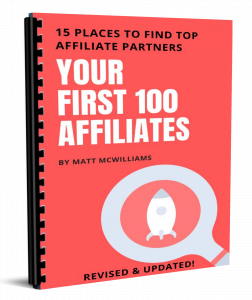 |
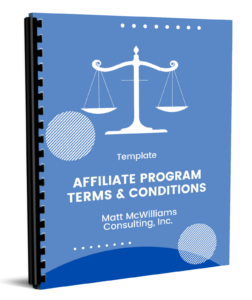 |
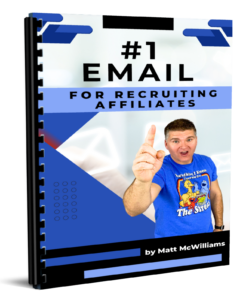 |
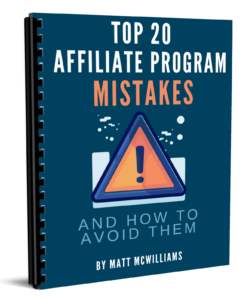 |
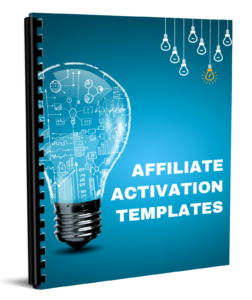 |
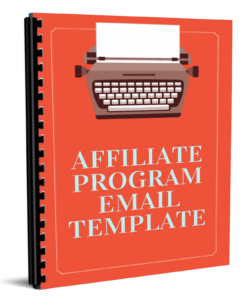 |
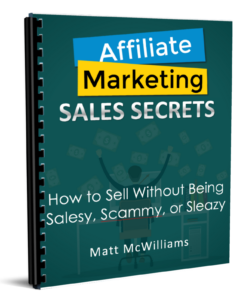 |
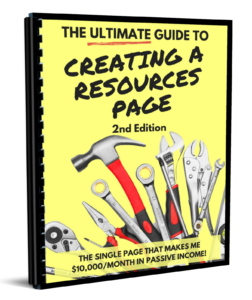 |
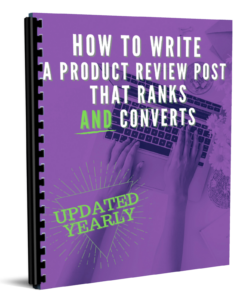 |

